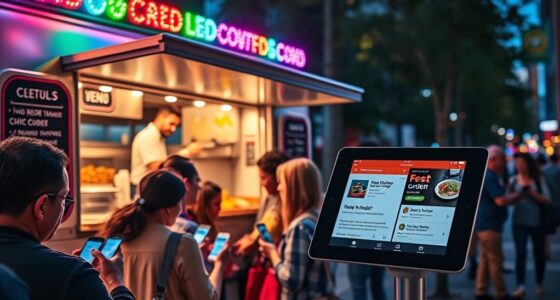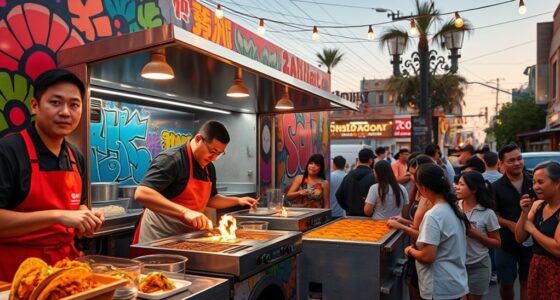The food truck industry is booming, driven by growth in urban areas and regional events that boost visibility and sales. You’ll see increasing consumer demand for healthier, sustainable, and globally-inspired menus, with fusion dishes and authentic regional flavors leading the way. Technology is transforming operations with contactless payments, mobile apps, and digital displays, while eco-friendly practices like biodegradable packaging and electric vehicles grow in importance. To discover how these trends create new opportunities, explore what’s shaping the industry today.
Key Takeaways
- Growing industry valuation and regional expansion driven by urbanization, outdoor dining, and event-based opportunities.
- Increasing menu innovation with diverse, authentic, and health-conscious flavors to attract adventurous consumers.
- Adoption of advanced technology like contactless payments, AI, AR, and digital displays for enhanced customer experience.
- Emphasis on sustainability practices, including eco-friendly packaging, renewable energy use, and waste reduction initiatives.
- Market fragmentation fostering niche offerings, collaboration, and adaptation to regional and cultural preferences.
Industry Growth and Market Dynamics
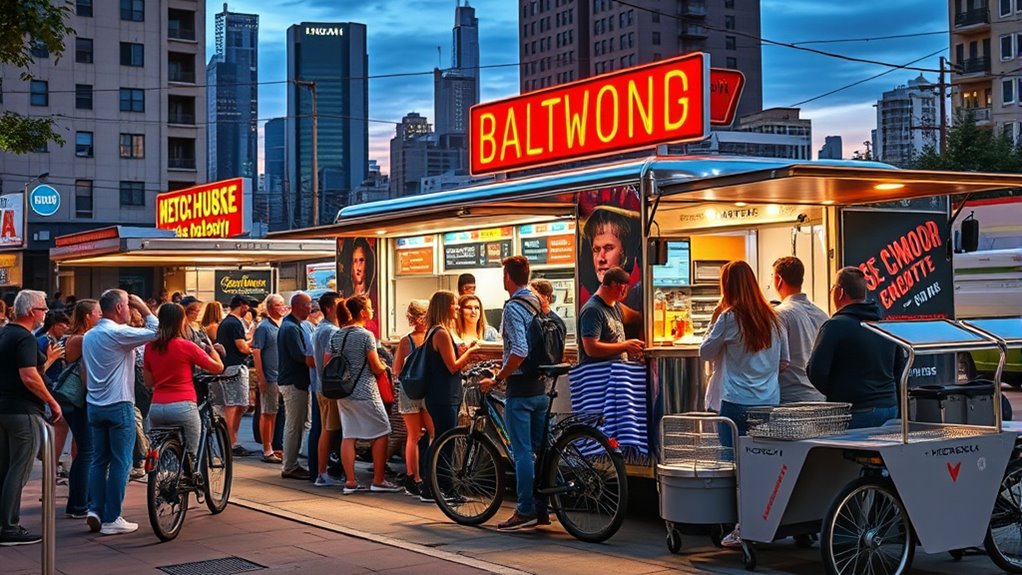
The food truck industry is experiencing rapid growth driven by changing consumer preferences and market dynamics. In the U.S., the market is valued at around USD 1.09 billion in 2025 and is projected to reach USD 1.51 billion by 2030, growing at a CAGR of 6.6%. Globally, the market is worth USD 4.90 billion in 2024 and is expected to nearly double to USD 8.78 billion by 2033, with a CAGR of about 6.7%. The U.S. industry alone is forecasted to hit USD 2.8 billion by 2025, with recent growth rates of 13.2% annually. The proliferation of trailers, especially in California and the U.S. West, along with franchise expansion, further fuels this booming sector driven by urbanization, busy demographics, and the appeal of mobility and street food. Market diversification across multiple regions continues to expand as secondary markets benefit from outdoor dining infrastructure and evolving consumer tastes. Additionally, integrating efficient general ledger coding practices can optimize financial management for these businesses, supporting sustainable growth and operational efficiency.
Evolving Consumer Preferences and Menu Innovations
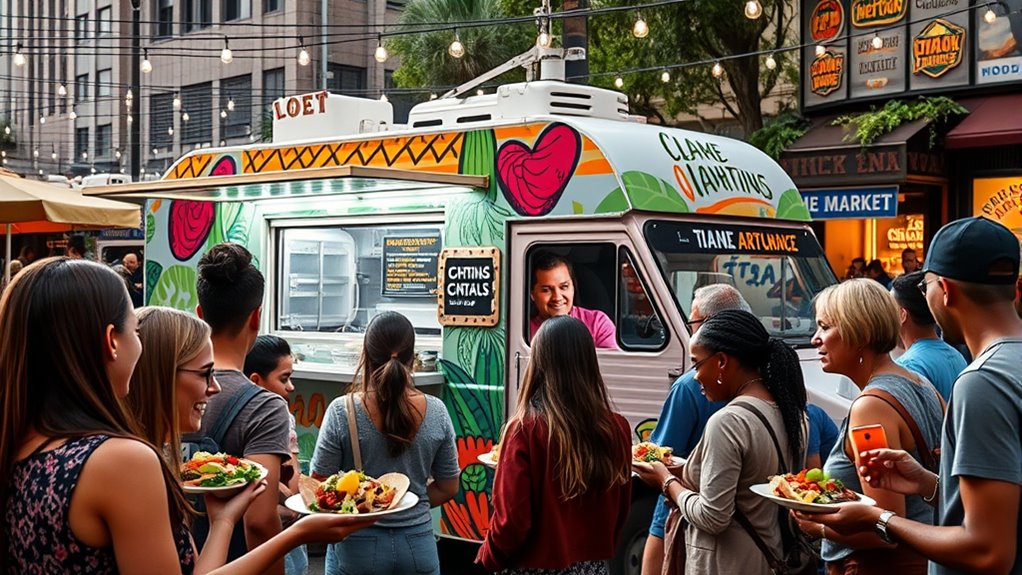
As consumer preferences shift toward health, sustainability, and diverse flavors, food trucks are adapting their menus to meet these evolving demands. You’ll find more vegan, vegetarian, and health-conscious options, like jackfruit tacos and vegan laksa, using alternative proteins such as Beyond Meat. This diversification attracts a broader audience enthusiastic for nutritious, global-inspired dishes.
Consider these innovations:
- Incorporation of eco-friendly ingredients sourced locally to reduce environmental impact.
- Adoption of biodegradable packaging and zero-waste cooking methods to promote sustainability.
- Fusion cuisines blending ethnic flavors with modern styles, creating unique, customizable street foods. Sustainable practices are becoming increasingly important as consumers seek brands that prioritize environmental responsibility, encouraging operators to incorporate eco-conscious methods into their menu offerings.
These menu innovations not only satisfy adventurous palates but also build trust with consumers who value transparency and ethical sourcing, strengthening your brand’s reputation.
Technology Adoption and Digital Transformation

Adopting technology has become essential for food trucks aiming to enhance efficiency and meet modern customer expectations. You’re likely using mobile apps and QR codes to reduce wait times and improve order accuracy, catering to customers’ desire for convenience and hygiene. Contactless payments like Apple Pay, Google Pay, and tap-to-pay cards speed up transactions and boost satisfaction. Modern POS systems, especially cloud-based ones, help you manage orders, inventory, and staff schedules while providing valuable data insights to optimize menus and boost profitability. You’re also exploring AI and AR to predict popular items, offer immersive menus, and personalize marketing. Additionally, integrating with smart city infrastructure and adopting renewable energy sources allows your truck to operate more sustainably, efficiently, and within evolving urban ecosystems. Incorporating color accuracy in digital displays can further enhance customer engagement by providing vibrant and appealing visuals.
Sustainability Practices and Eco-Friendly Initiatives
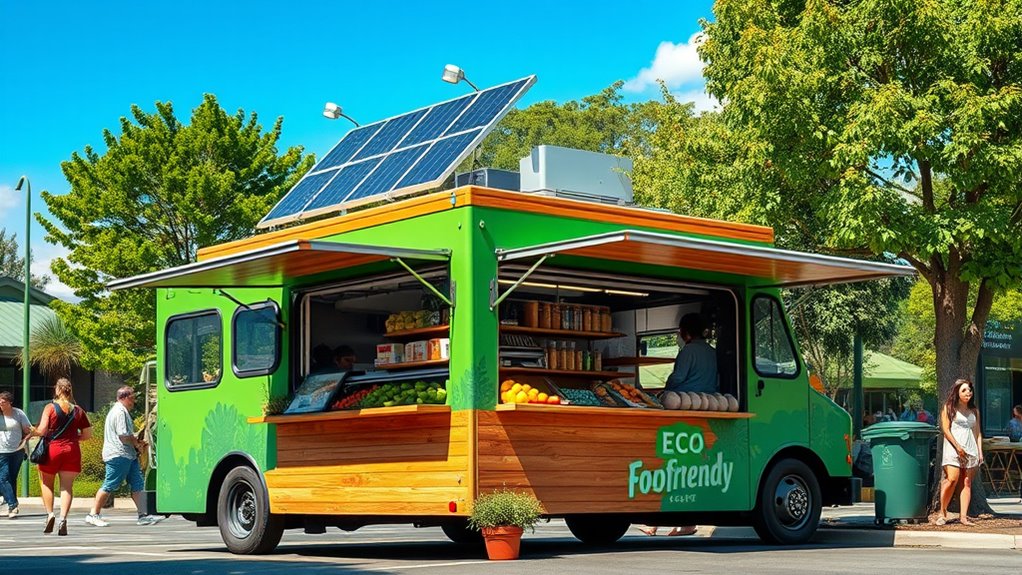
Implementing sustainability practices has become a key strategy for food trucks seeking to reduce their environmental impact and appeal to eco-conscious customers. By adopting eco-friendly initiatives, you can stand out and lower costs. Here are three impactful ways:
- Use biodegradable or compostable packaging, which over 60% of trucks already do, reducing plastic waste and attracting green-minded clients. sustainable packaging can also improve customer perception and loyalty.
- Compost organic waste, a practice nearly half of food trucks follow, diverting waste from landfills and decreasing methane emissions.
- Switch to renewable energy sources like solar panels or electric vehicles, cutting fuel costs by around 15% and considerably lowering carbon emissions.
– Additionally, the industry’s market size is projected to grow from $19.4 billion in 2022 to $26.3 billion by 2027, emphasizing the increasing importance of sustainable practices in future growth. industry growth These practices not only support environmental responsibility but also enhance your brand’s reputation and profitability, resonating with consumers who prioritize sustainability.
Regional and Event-Driven Opportunities
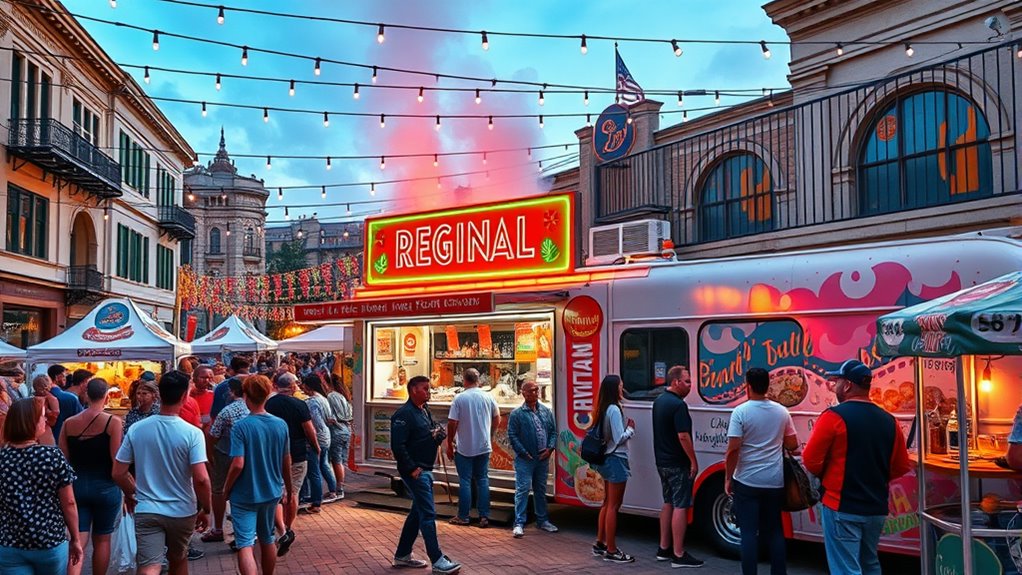
You can capitalize on festival and event peaks by targeting regional gatherings that draw large crowds, boosting your sales considerably. Paying attention to regional flavor trends allows you to customize menus that resonate with local tastes and preferences. Additionally, forming partnerships with nearby businesses and institutions opens doors for ongoing corporate and campus collaborations, creating stable revenue streams. Regional differences in revenue and market size further emphasize the importance of tailoring your strategy to local opportunities and consumer behavior. Incorporating insights from pinball culture and community can inspire innovative promotional events that engage local audiences and foster loyalty.
Festival and Event Peaks
Festival and event peaks present prime opportunities for food trucks to maximize revenue and build brand awareness. Attending festivals can dramatically boost your sales and visibility. Consider these key advantages:
- High Attendance: Events like Black Food Truck Festivals saw growth from 3,500 to 15,000 attendees, creating a large customer pool.
- Revenue Potential: Gross sales can exceed $8,000 per event, with some festivals generating over $340,000 in vendor revenue, including desserts.
- Social Media Impact: Festivals generate over a million Facebook impressions, helping you reach thousands of potential new followers and customers.
These peaks attract diverse crowds, allow you to test new menu items, and foster repeat business. Participating in festivals is a strategic move to elevate your brand and boost short-term income.
Regional Flavor Trends
Regional flavor trends are shaping the food truck industry by emphasizing authentic, locally inspired menus that resonate with consumers seeking genuine cultural experiences. You’ll see a focus on traditional recipes led by immigrant communities, with stories behind each dish that deepen customer connections. Incorporating regional ingredients like vegetables—such as cabbage, broccoli, and cauliflower—adds authenticity and highlights regional culinary traditions. Food trucks often serve iconic local dishes, like Texas brisket or Hawaiian fish tacos, boosting loyalty and emphasizing cultural heritage. Sourcing ingredients locally supports sustainability and appeals to eco-conscious customers, while social media plays a key role in showcasing regional uniqueness. This approach not only celebrates regional identity but also builds a strong, authentic brand, attracting diners enthusiastic for real, memorable flavors. Flavor complexity and sensory engagement play a crucial role in creating memorable food experiences that encourage repeat visits. Additionally, focusing on regional ingredients enhances authenticity and connects diners to the local culture.
Corporate Collaboration Opportunities
Food trucks are increasingly partnering with corporations to expand their reach through regional and event-driven collaborations. These partnerships boost visibility, attract new customers, and create unique experiences. Over 24,000 food trucks operate across the United States as of 2023, highlighting the industry’s growth and potential for collaborative opportunities. Here are three ways this happens: 1. Regional Food Festivals: Corporate sponsorships often include co-branded marketing, logistical support, and exclusive regional menus, drawing larger crowds and enhancing event appeal. 2. Event Activations: At concerts, sports, or conventions, food trucks serve as mobile brand ambassadors, offering customized menus and branded packaging that boost consumer engagement. 3. Corporate Catering & Delivery: Companies hire food trucks for employee events and partner with delivery platforms, enabling recurring visits, digital promotions, and access to new markets, all while supporting sustainability initiatives. Additionally, these collaborations can help food trucks build brand recognition and foster community connections, further strengthening their market presence.
Financial Considerations and Operational Costs

Managing the financial aspects of a food truck business requires careful attention to operational costs, which can substantially impact profitability. Monthly expenses in 2025 range from $5,000 to $10,000, reflecting inflation in fuel, labor, and supplies. Keeping costs below 65–70% of revenue is vital for profitability. You can reduce expenses by up to 20% through efficiency measures like AI-driven inventory management and zero-commission ordering platforms. Fuel costs, often $500 to $1,000 monthly, are a major expense, especially in larger trucks and high-tax regions. Labor costs also weigh heavily, with wages rising due to minimum wage hikes and staffing shortages. Initial investments, averaging over $100,000 for new trucks, include permits, equipment, and insurance. Regulatory costs and permits further add to expenses, emphasizing the importance of careful financial planning. Additionally, understanding vehicle tuning options can help optimize engine performance and fuel efficiency, potentially reducing operating costs over time.
The Role of Independent Operators and Market Fragmentation
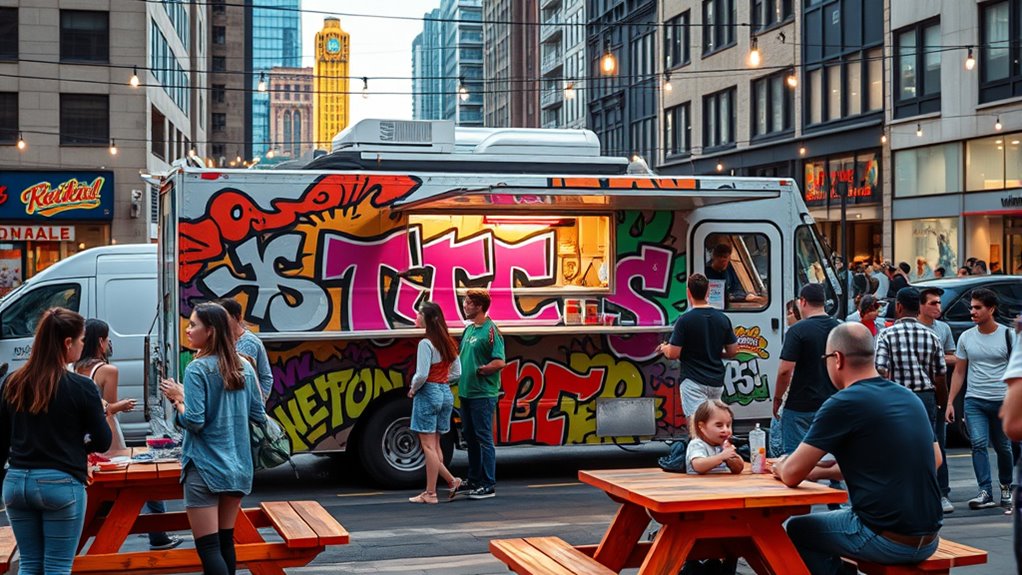
You’ll notice that independent operators dominate the food truck scene, making up around 86-91% of the industry, which keeps the market highly fragmented. This decentralization offers opportunities for niche players to succeed by catering to specific tastes and local preferences. With no single company holding significant market share, small-scale operators thrive through innovation and community engagement. Emphasizing market fragmentation allows for diverse business models and specialized offerings that can adapt quickly to changing consumer demands.
Industry Decentralization Dynamics
The industry’s decentralization is primarily driven by the dominance of independent operators, who make up approximately 86% to 91% of the U.S. market. This creates a highly fragmented landscape where no single player controls more than 5% of the market share. You’ll notice that:
- The low barriers to entry encourage entrepreneurs to start their own trucks, fueling continuous industry growth.
- Market fragmentation fosters competition based on niche offerings, personalized service, and local marketing rather than scale.
- Variations in regulations and zoning require operators to adapt independently, often leading to diverse operational practices and branding efforts.
- The variety of USB cable types used by food truck operators for equipment and charging needs illustrates their adaptability and the importance of compatible accessories in mobile business operations.
This decentralization allows for innovation, regional customization, and resilience, but also introduces challenges like inconsistent standards and limited marketing reach.
Market Share Distribution
Why does the food truck industry remain so fragmented? It’s mainly because many independent operators dominate the scene, fueled by low entry costs—especially for trailers, which hold 43.27% of the U.S. market. This diversity creates a patchwork of local, niche, and regional players. Larger chains and franchises grow steadily at 8.14% CAGR, but independents still outnumber them and bring unique flavors. The market’s split is clear:
| Segment | Market Share / Growth |
|---|---|
| Independent Trucks | Largest, highly fragmented |
| Trailers | 43.27%, favored for affordability |
| Franchise Trucks | 8.14% CAGR, expanding presence |
| Major Cities | 500+ trucks each, high competition |
| Regional Markets | High fragmentation, local focus |
Opportunities for Niche Operators
Market fragmentation creates ample opportunities for niche operators to thrive by targeting underserved segments and customizing their offerings. With about 86% of U.S. food trucks being independent, you can leverage low start-up costs—ranging from $50,000 to $200,000—to enter the market easily. Your flexibility allows you to adapt menus swiftly to local tastes and emerging trends, building a loyal customer base through personalized service and unique branding. The rising demand for diverse culinary options across regions offers further growth potential for specialized food trucks that cater to specific tastes and preferences. Consider these opportunities:
- Specialize in ethnic, gourmet, or sustainable cuisines to meet rising demand for diverse options.
- Use social media and geofencing to target local customers and boost foot traffic.
- Focus on locally sourced ingredients to appeal to eco-conscious consumers and stand out from larger chains.
Impact of Premium and Global Flavors on Menu Offerings
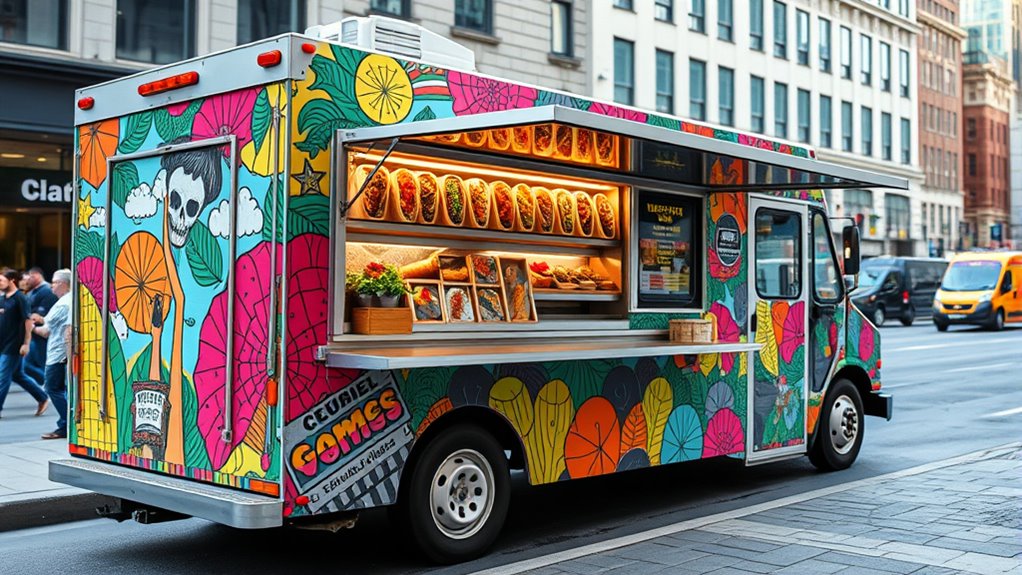
Premium and global flavors profoundly shape food truck menus by enabling operators to stand out through high-quality ingredients and authentic culinary experiences. By focusing on distinctive ingredients and unique cuisines, you can justify premium pricing and create a strong brand identity. Limited, focused menus with ingredient cross-utilization help you maximize cost efficiency while highlighting specialty offerings like keto, paleo, or gluten-free options, appealing to underserved markets willing to pay more. Trucks specializing in desserts or beverages with artisanal, premium products often enjoy high margins—over 30%. Incorporating global flavors like ube or pistachio taps into viral trends, attracting adventurous customers. These flavors help you differentiate your menu, foster loyalty, and position your truck as a destination for authentic, high-quality, and culturally diverse food experiences. Embracing culinary innovation allows operators to stay ahead of market trends and meet evolving consumer preferences.
Future Outlook and Emerging Trends
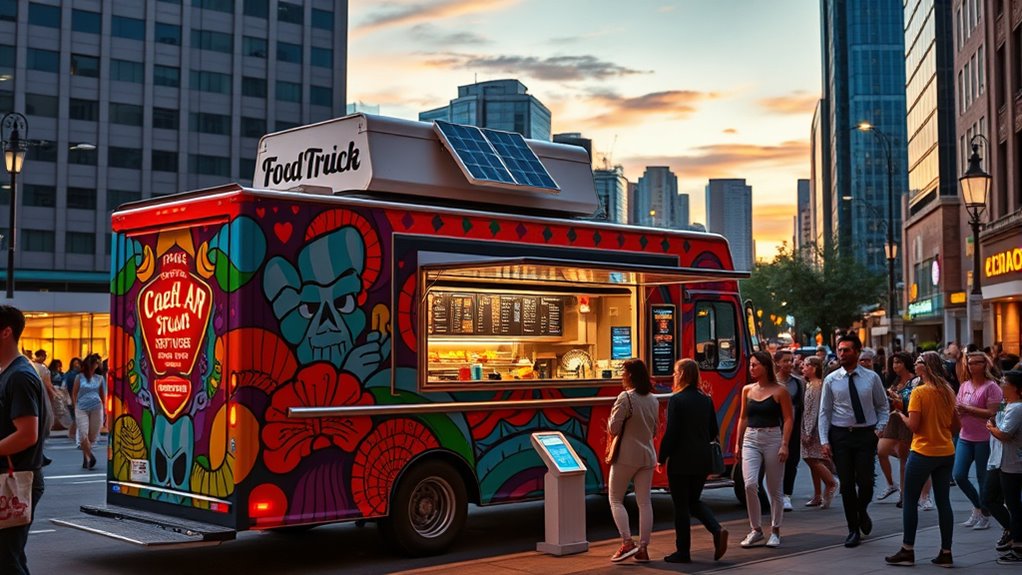
The food truck industry is embracing innovative technologies and sustainable practices that are shaping its future landscape. You can expect a shift toward greener energy and smarter operations. Here are three key trends:
- Clean and sustainable tech: Electric and solar-powered trucks are becoming more common, cutting fuel costs by about 15%, while eco-friendly packaging and sourcing locally reduce environmental impact. Electric vehicles are increasingly affordable and supported by government incentives, making eco-friendly options more accessible for operators.
- Advanced automation: AI-driven management systems improve efficiency, with voice ordering at 83–88% accuracy, and predictive menu engineering helps optimize inventory and sales.
- Expansion into new markets: Food trucks are moving into corporate events, city zones, and festivals, boosting visibility and sales. Virtual brands and digital-first models also expand reach and revenue streams.
These trends signal a more sustainable, tech-enabled, and diverse future for the industry.
Frequently Asked Questions
How Are Food Trucks Adapting to Rising Health-Conscious Consumer Demands?
You notice that food trucks are adapting to rising health-conscious demands by adding more plant-based and wholesome options, like vegan laksa and jackfruit tacos. They source local ingredients, use eco-friendly packaging, and incorporate technology for personalized orders. You’ll find healthier menu choices, transparency about ingredients, and customizable meals that meet dietary needs. These changes help trucks attract health-minded customers and stand out in a competitive market.
What Innovative Tech Tools Are Most Effective for Food Truck Operations?
You should consider using innovative tech tools like real-time inventory management software, which helps prevent stockouts and reduces waste. Mobile POS systems enable quick, contactless payments and streamline transactions, even offline. Analytics tools give you valuable insights into sales and costs, helping you make data-driven decisions. Automation features like reordering and customer outreach campaigns further enhance efficiency, allowing you to focus on delivering great food and service on the go.
How Do Sustainability Initiatives Impact Food Truck Profitability?
Sustainability initiatives are the wind beneath your wings, lifting your food truck’s profitability. By cutting energy costs, reducing waste, and attracting eco-conscious customers, you boost revenue and brand loyalty. Sourcing local ingredients and eco-friendly packaging not only saves money but also sets you apart in a crowded market. While initial investments can be high, the long-term gains—better margins and a stronger reputation—make sustainability a smart strategy for growing your business.
What Are the Best Strategies for Food Trucks to Succeed at Festivals?
To succeed at festivals, you should focus on quick setup and breakdown, aiming for under 15 minutes, to maximize sales time. Manage attendee flow effectively to cut queues by 25%, and optimize staff during peak hours for better service. Promote your brand actively through social media, participate in community events, and offer seasonal or themed promotions. Use digital tools like loyalty apps and online orders to boost repeat visits and overall profitability.
How Is the Industry Supporting Independent Operators Amidst Market Fragmentation?
Imagine you’re steering a vast, fragmented marketplace, where independence is your sail and innovation your wind. The industry supports you through lower startup costs, allowing you to launch without sinking deep into debt. Franchising and digital platforms act as guiding stars, offering support and reach. Community events and government backing strengthen your fleet, helping you adapt and thrive amid the chaos and competition. You’re empowered to steer your food truck toward success.
Conclusion
As you navigate the ever-changing food truck scene, remember that adaptability is key. Embrace new tech, cater to evolving tastes, and prioritize sustainability to stay ahead. Regional opportunities and global flavors add to your menu’s appeal, but don’t forget that “the early bird catches the worm.” By staying flexible and innovative, you’ll position yourself for long-term success in this dynamic industry.


